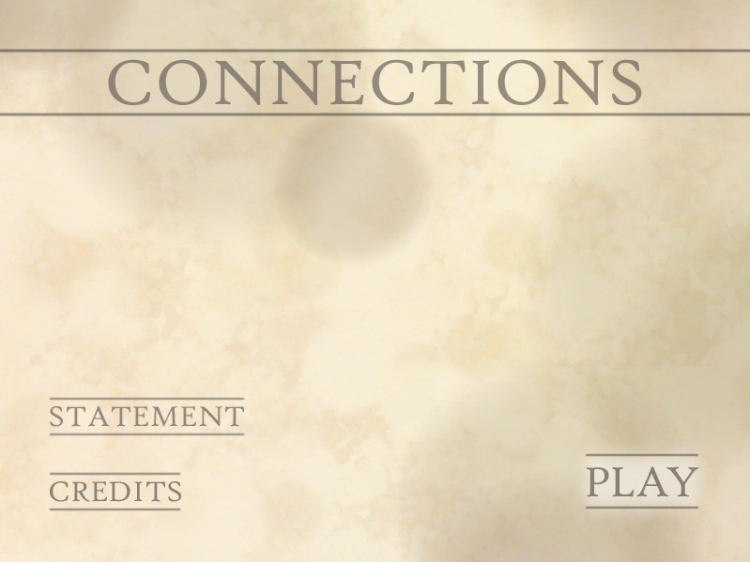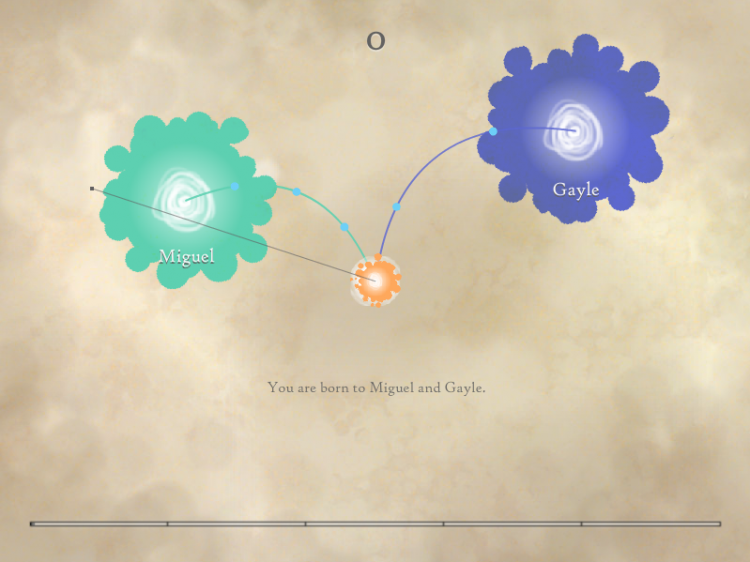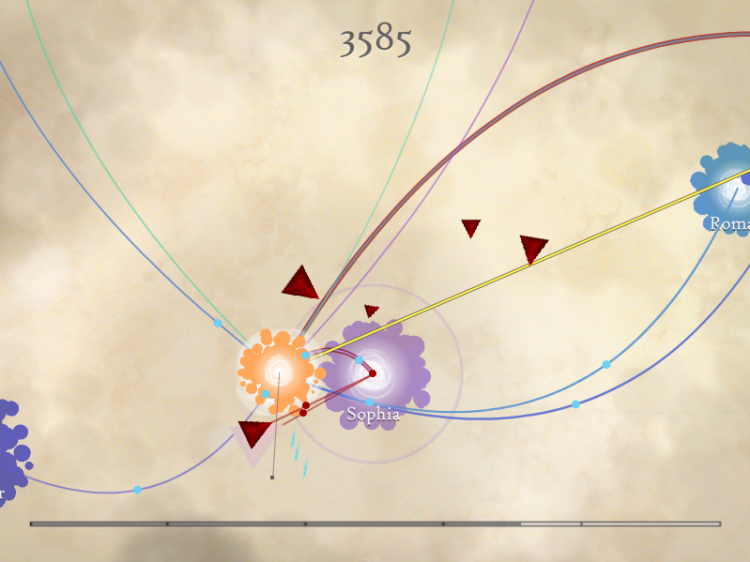[As part of our project, mindful xp is committed to documenting our progress – part of that is creating post-mortems for our games. Post-mortems are very candid about game details, so if you don’t want a game’s experience spoiled before you play, reading these might not be in your best interest.]
Connections is an abstract shooter that deals directly with the difficulty of maintaining relationships over time and distance. It was the second project developed for mindful xp and the first game we developed in Flash.
You can play Connections on our website, on Kongregate, or on Newgrounds.
Development:
Within mindful xp we consider Connections to be our “first” project. While R-evolution (our first release) was developed within mindful xp, it was an idea we had brainstormed while outside the project semester. Connections represented the first time we as a team had gone completely through the process of brainstorming, designing, developing, and releasing the game entirely within the context of our project.
In the game Connections you play a “person” with the ability to move around and focus attention on other people via “attention bullets”. If you focus enough attention on a person a relationship is formed with them and they begin to send you back attention which helps nourish you and can be used to form new relationships. However if you don’t maintain focus on a relationship eventually the relationship will wither and end and your connection will be lost to that person.
What Went Right:
1. Strong Core Message
The first thing that went right was coming up with a core message for the game. Even though this was our first game, we intuitively decided upon coming up with a strong message that might provide some insight for players. The decision to not just focus on relationships, but specifically how relationships need to be maintained over time and distance was a useful message that really focused the mechanics and play of the game.
Rather than trying to build systems around modeling relationships in all their complexity, we instead focused on the aspect of forming relationships (by giving attention to a person) and having to maintain attention on people throughout a relationship. By concentrating on this single aspect of relationships we could give more attention and depth to the mechanics and system associated with that rather than have a set of weakly developed mechanics attempting to simulate every part of being in a relationship with someone.
2. Creating Personalities
One idea we also formed early on was that even though people were represented as abstract blobs that they should each have their own “personality”. While the people didn’t interact or communicate with the player in a lot of ways, we had built enough of a system to have a personality seep through.
Basically we used a very simplified version of the standard Myers-Briggs personalities to form how people would react to the player’s actions and help the player once they were in a relationship. We then roughly translated this into actions the people could engage in within our game systems. A person who was more outwardly going might be easier to form a relationship with, a person with who favored feeling over thinking might send out more attention back to the player, etc. The variables we juggled were ease of forming relationship, how quickly relationships dwindled without attention, how much attention they sent back to the player, and if they also aided the player in destroying distractions.
By creating a system that randomized the personalities of the people, we were quickly and easily able to create a variety of people and scenarios for players to engage in. Players seemed to be able to distinguish different types of people even if they didn’t exactly know the underlying system, but they definitely seemed to associate personality traits with people like greedy, caring, selfish, and kind.
3. Adding Bits of Narrative
At key moments in Connections bits of text pop up to provide context to the player. These sentences can be as simple as informing the player a new connection has been created and defining the relationship or include a little bit of narrative elements such as rekindling an old love or reforming a relationship with a parent.
These narrative elements were one of the strongest parts of the game and created the most emotionally resonant moments in players. Whenever players committed an action we reinforced and clarified the outcome of that action with a bit of narrative text. Beyond just adding flavor to the game, it reminded people that they not just operating in a completely abstract space, but instead where involved in a system that represented relationships.
At the end of the game players were also treated to the complete list of actions that had occurred in the game. This final list that basically acted as a mini-biography of the player’s actions in their lifetime really drove home the point on how many relationships were created, lost, and reformed throughout the game.
4. Polishing the Final Game
Connections took approximately 10 days to completely from brainstorming to release. Within our project we initially had hoped to complete a game every 7 days and maintaining a game-per-week schedule. And with Connections we did have a completed game within a week of development. However the game at that point wasn’t polished. While the basic gameplay mechanics, systems, and general feel was in the game, there was still a lot of aspects missing. We were missing narrative text, the ending scroll, and the personalities were not fully implemented for the people. Additionally we were missing small minor polish elements in menu and presentation.
So while the game was technically complete in a prototype stage it was not fully realized. More importantly we felt that the meaning, the message that formed the core of our game, was not fully communicated. If we released the game at this point, while we would have a “finished” game, we would not be accomplishing our goal of creating a game that could act as meaningful experience for the player.
We decided to continue working on the game at this point. This was a crucial moment for our project. We realized that we were not just about rapid prototyping and releasing prototypes, but that our true end goal was creating fully-realized games that conveyed expression and meaning to the best of our abilities. In the end pushing the game release back 3 days to work on it further ended up being the right decision, as the changes we made to polish the game made the game better and more expressive.
What Went Wrong:
1. Initial Brainstorming
With brainstorming we originally had no structure in place to focus our brainstorming efforts. Instead we had naively hoped that we could sit down, discuss for a little while, and come out with a plan for designing a meaningful game. With hindsight this was completely unrealistic and as we sunk into our first brainstorm session we realized that without any direction we could spend hours thinking of various ideas without coming up with any strong game designs.
In order to overcome this we quickly devised an ad-hoc brainstorming structure for thinking about how to approach game designs with a message or meaning we wished to convey. This structure where we focused on the initial message, broke that down into individual components, translated those components into gameplay elements, and combined them into a system of gameplay, became the basis of how we approached most brainstorming for the rest of the semester. The “meaningful games framework” was a useful tool for structuring our brainstorm sessions which still took some time, but definitely helped us focus on the end goal of walking away with a game idea everyone was satisfied with.
2. Those Red Triangles
Oh those red triangles. For the game we need to add some external enemy that distracted the players from the task of just maintaining relationships. Our attempt to create this challenge was the red triangles. These triangles acted as typical enemies in a shooter. They traveled around, hunted down the player, and attacked other people. The concept of the red triangles is they represented distractions in life, whether that be something as simple as a job, medical problems, or anything else in life that needs to be done outside of talking with friends and family.
However in our attempt to simplify the system, we went a little too far with the red triangles. Because they represented such a broad range of things they ended up really symbolizing nothing, instead being weird nonsequiters. They never represented a significant enough challenge to really become a distraction and instead made the player treat the game more like a typical shooter.
We knew we were definitely having issues when one of our advisers, Jesse Schell, asked us if we could concretely define what the red triangles were. We couldn’t. In hindsight it would have been better to focus on creating distractions and events that were more closely tied into the system of maintaining relationships. Having specific events represented and communicated that tied into the narrative of communication with other people would have been a much stronger way of creating distractions for the player.
Conclusion:
Connections has gone on to be one of our most successful games from the mindful xp project, with over 10,000 plays across our website, Newgrounds, and Kongregate. Beyond just pure playcount though, the response from people has been fantastic and beyond anything we expected. There have been a lot of players who really connected (no pun intended) with the game and talked about how they interpreted the game through their own personal experience with family and friends. Making the game was an incredibly satisfying experience and going forward a lot of the important things we ended up learning about our project and meaning/expression was first formulated in this important “first” game.


